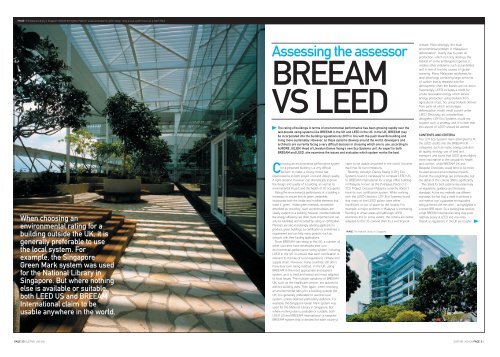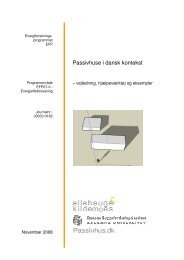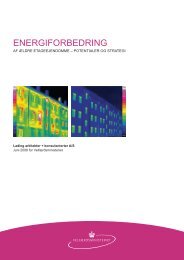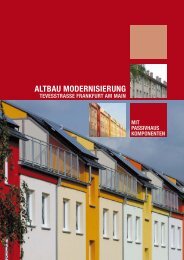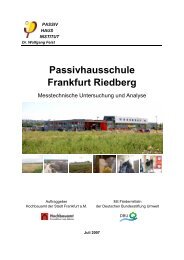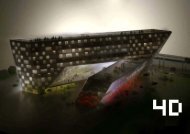BREEAM vs. LEED Sustain Magazine
BREEAM vs. LEED Sustain Magazine
BREEAM vs. LEED Sustain Magazine
Create successful ePaper yourself
Turn your PDF publications into a flip-book with our unique Google optimized e-Paper software.
IMAGE: The National Library in Singapore received the highest ‘Platinum’ award achievable for green design, using a local system known as a Green Mark<br />
When choosing an<br />
environmental rating for a<br />
building outside the UK, it is<br />
generally preferable to use<br />
the local system. For<br />
example, the Singapore<br />
Green Mark system was used<br />
for the National Library in<br />
Singapore. But where nothing<br />
else is available or suitable,<br />
both <strong>LEED</strong> US and <strong>BREEAM</strong><br />
International claim to be<br />
usable anywhere in the world.<br />
Assessing the assessor<br />
<strong>BREEAM</strong><br />
VS <strong>LEED</strong><br />
The rating of buildings in terms of environmental performance has been growing rapidly over the<br />
last decade using systems like <strong>BREEAM</strong> in the UK and <strong>LEED</strong> in the US. In the UK, <strong>BREEAM</strong> may<br />
be incorporated into the building regulations by 2019 in line with the push towards building and<br />
living more sustainably. However, as these systems develop around the world, developers and<br />
architects are currently facing a very difficult decision in choosing which one to use, according to<br />
AURORE JULIEN, Head of Llewelyn Davies Yeang’s new Eco Systems unit. An expert in both<br />
<strong>BREEAM</strong> and <strong>LEED</strong>, she examines the issues and evaluates which system works the best.<br />
Choosing an environmental-performance system<br />
for a proposed building is a very difficult<br />
decision to make; a wrong choice has<br />
repercussions to both project cost and design quality.<br />
A right decision, however, can dramatically improve<br />
the design and quality of a building, as well as its<br />
environmental impact and the health of its occupants.<br />
Rating the environmental performance of a building is<br />
necessary to ensure that its green credentials<br />
incorporate both the visible and invisible elements that<br />
make it ‘green’. Visible green methods, sometimes<br />
described as ‘eco-bling’, such as photovoltaics, are<br />
clearly evident on a building; however, invisible methods<br />
like energy efficiency are often more important and can<br />
only be identified and recorded by rating or certification.<br />
Planners are also increasingly advising applicants to<br />
produce green buildings, so certification is sometimes a<br />
requirement and can help many projects, such as<br />
schools, with their funding applications.<br />
Since <strong>BREEAM</strong> was setup in the UK, a number of<br />
other countries have developed their own<br />
environmental-performance rating system, including<br />
<strong>LEED</strong> in the US, to ensure that each certification is<br />
relevant to the like of local regulations, climate and<br />
supply chain. However, many countries still don’t<br />
have their own rating method. In the UK, using<br />
<strong>BREEAM</strong> is the most appropriate and easiest<br />
system, as it is tried and tested and most adapted<br />
to local issues. The multiple variations of <strong>BREEAM</strong>-<br />
UK, such as the healthcare version, are tailored to<br />
distinct building uses. Then again, when choosing<br />
an environmental rating for a building outside the<br />
UK, it is generally preferable to use the local<br />
system, unless deemed particularly deficient. For<br />
example, the Singapore Green Mark system was<br />
used for the National Library in Singapore. But<br />
where nothing else is available or suitable, both<br />
<strong>LEED</strong> US and <strong>BREEAM</strong> International (a bespoke<br />
<strong>BREEAM</strong> system that is devised for each country)<br />
claim to be usable anywhere in the world, however<br />
each has its own limitations.<br />
Recently Llewelyn Davies Yeang (LDY) Eco<br />
Systems found it necessary to compare <strong>LEED</strong> US<br />
to <strong>BREEAM</strong> International for a large office building<br />
in Malaysia, known as the Putrajaya Precinct 2 -<br />
2C5 Project, because Malaysia currently doesn’t<br />
have its own certification system. While working<br />
with the <strong>LEED</strong> checklist, LDY Eco Systems found<br />
that many of the <strong>LEED</strong> points were either<br />
insufficient or out of place for the locality. For<br />
example, a major problem in Malaysia is increasing<br />
flooding in urban areas and although <strong>LEED</strong><br />
examines this to some extent, the criteria are better<br />
adapted to the US context than to a wet tropical<br />
IMAGE: The National Library in Singapore<br />
climate. More strikingly, the main<br />
environmental problem in Malaysia is<br />
deforestation, mainly due to palm oil<br />
production, which not only destroys the<br />
habitat of some endangered species, it<br />
creates other problems such as landslides<br />
and is one of the key causes of global<br />
warming. Many Malaysian rainforests lie<br />
atop peat bogs containing large amounts<br />
of carbon that is released into the<br />
atmosphere when the forests are cut down.<br />
Surprisingly, <strong>LEED</strong> includes a credit for<br />
onsite renewable energy which allows<br />
energy production using biofuels from<br />
agricultural crops. So, using biofuels derived<br />
from palm oil which encourages<br />
deforestation would credit a point under<br />
<strong>LEED</strong>. Obviously, as conscientious<br />
designers, LDY Eco Systems would not<br />
support such a strategy and it is clear that<br />
this aspect of <strong>LEED</strong> should be altered.<br />
CONTENTS AND CRITERIA<br />
The LDY Eco Systems team attempted to fit<br />
the <strong>LEED</strong> credits into the <strong>BREEAM</strong> UK<br />
categories, such as water, energy, pollution,<br />
air quality, ecology, use of land and<br />
transport, and found that <strong>LEED</strong> gives slightly<br />
more importance to the occupant’s health<br />
and comfort, while <strong>BREEAM</strong> UK and<br />
Bespoke Checklists would tend to be more<br />
focused around environmental impacts.<br />
Overall, the weightings are comparable, but<br />
the detail of the criteria differs significantly.<br />
The criteria for both systems rely extensively<br />
on regulations, guidance and third-party<br />
standards. As the two methods use different<br />
standards, the fact that a credit is achieved in<br />
one method won’t guarantee the equivalent<br />
being achieved with the other – as highlighted in<br />
a recent BRE report. So a building that receives<br />
a high <strong>BREEAM</strong> International rating may score<br />
relatively poorly at <strong>LEED</strong>, and vice-versa.<br />
Overall, as regulations in the UK are tougher<br />
PAGE 30 SUSTAIN’ v09 i06<br />
SUSTAIN’ v09 i06 PAGE 31
IMAGE: Great Ormond Street Hospital for Children obtained an ‘Excellent’ NEAT rating, part of the BRE’s <strong>BREEAM</strong> system<br />
than in the US, the criteria from <strong>BREEAM</strong> UK may be slightly<br />
more onerous than that of <strong>LEED</strong> and this difference may be<br />
reflected in <strong>BREEAM</strong> International to some extent. However,<br />
<strong>BREEAM</strong> International uses local guidance, regulations,<br />
climatic distinctiveness and environmental priorities, so<br />
ultimately it is very likely that its criteria are easier to comply<br />
with than <strong>LEED</strong>. And, for many major <strong>LEED</strong> credits, American<br />
standards for heating and energy must be used along with<br />
Imperial units, so the conversion of these measurements<br />
makes the process more complex and arduous.<br />
COSTS<br />
There is very little information about the constructioncost<br />
implications of pursuing <strong>LEED</strong> or <strong>BREEAM</strong> for<br />
international projects. Added construction costs will<br />
depend on how the regional standards compare to the<br />
assessment standards. And where, for example, some<br />
sources give added costs of 3 to 8 per cent of<br />
construction costs for <strong>LEED</strong> accreditations, one could<br />
expect that these might be significantly higher should<br />
the system be applied to a non-US country. This may<br />
partly be due to building regulations being disparate (for<br />
example, in relation to energy performance). The other<br />
added difficulty is that supply processes, contractors and<br />
suppliers may not be familiar or adapted to the<br />
requirements, or there may be a lack of green building<br />
products. As <strong>BREEAM</strong> International is bespoke to each<br />
country, it is expected that the added cost may be equal<br />
or possibly lower than that of <strong>LEED</strong> despite a higher<br />
level of environmental performance.<br />
THE <strong>BREEAM</strong> PROCESS<br />
Evidently <strong>BREEAM</strong> International methodology has the<br />
potential to be more relevant to local needs, resulting in a<br />
more appropriate design and a system that is easier to<br />
implement. However, this summer LDY Eco Systems was<br />
asked by a client to prepare a quotation for an<br />
environmental assessment, so the team contacted the BRE<br />
in the hope of carrying out a <strong>BREEAM</strong> International<br />
assessment. Unfortunately, the BRE was unable to<br />
respond to queries for two months, whereas the US Green<br />
Building Council was immediately responsive.<br />
Setting up bespoke standards for new countries or<br />
projects each time is a huge undertaking, and appears<br />
to have resulted in the <strong>BREEAM</strong> office being unable to<br />
deal with the demand. This is risky for clients within<br />
the context of starting a new environmental<br />
assessment, because in order to achieve a high score<br />
at <strong>BREEAM</strong> it is essential to look at the credits list as<br />
early as possible.<br />
LDY Eco Systems addressed these issues with the<br />
<strong>BREEAM</strong> office, which responded with the promise<br />
that processes were due to improve dramatically; the<br />
BRE is ‘streamlining’ the system to make it more<br />
efficient by standardising elements rather than starting<br />
from scratch each time. In fact, results are already<br />
evident, with the team’s last request being answered<br />
within days. Additionally, the BRE suggested that the<br />
first draft criteria checklists could be available within<br />
two weeks of the projects being registered.<br />
It is clearly very important that this process is<br />
managed well to ensure that objectives for<br />
environmental performance are implemented and<br />
evaluated throughout the design and construction of a<br />
building. Ultimately, each country should have their own<br />
system that is run by local people who understand<br />
issues such as local planning regulations, the supply<br />
chain and climate, making the process much more<br />
effective. However, where there isn’t a country-specific<br />
system, <strong>BREEAM</strong> International is a serious contender to<br />
<strong>LEED</strong> and quite possibly the better option in achieving<br />
greener, high-quality buildings.<br />
CASE STUDIES<br />
MITTAL CHILDREN’S MEDICAL CENTRE, GREAT<br />
ORMOND STREET HOSPITAL, LONDON<br />
Llewelyn Davies Yeang has designed a new ‘green’<br />
building for Great Ormond Street Hospital (GOSH)<br />
that will set the standard for new hospitals in the<br />
21st century. Due for completion in 2011, GOSH<br />
doesn’t display any of the ‘eco gadgets’ that usually<br />
mark out a green building; there are no photovoltaics,<br />
wind turbines or greywater systems. Yet despite this,<br />
GOSH is a green building that uses resources<br />
efficiently and reduces its impacts on human health<br />
and the environment.<br />
The new development will save about 60 per cent<br />
carbon emissions over the building regulations<br />
standards. It will reduce its impact on the environment<br />
through both its construction and operation, whilst<br />
offering the levels of comfort and functionality which<br />
are required for a modern hospital. A lower ecological<br />
footprint will be achieved through using land more<br />
efficiently, improving the local ecology, consuming less<br />
energy and using green materials. The Building<br />
Research Establishment predicted a score of 77 per<br />
cent or “Excellent”, using NEAT, the NHS<br />
environmental assessment method.<br />
The scheme submitted for planning application<br />
combines an optimised bioclimatic design approach<br />
with carefully engineered solutions for energy<br />
efficiency, a site-wide distribution system, and a<br />
2.8MWe biofuel/natural-gas Combined Cooling Heat<br />
and Power system to deliver a Carbon Negative<br />
Phase 2 scheme, and thus a benchmark for<br />
sustainable development by any standard.<br />
NATIONAL LIBRARY OF SINGAPORE, SINGAPORE<br />
Designed by Llewelyn Davies Yeang’s sister<br />
company TR Hamzah Yeang Sdn.Bhd., the National<br />
Library of Singapore was completed in 2005. It<br />
received the 2005 Singapore Green Mark Platinum<br />
Award, the highest award achievable for green<br />
design, as well as the 2005 World Association of<br />
Chinese Architects Gold Medal.<br />
The use of green garden spaces throughout the<br />
library provides a positive psychological effect on<br />
building users and improves general working<br />
environments. The actual design of the building is an<br />
assemblage of distinctive sun-shading blades (6m<br />
deep at some locations) that boldly define the<br />
tropical aesthetics for the building, as well as<br />
providing solar shading and anti-glare performance<br />
that in totality produces a contemporary climaticresponsive<br />
built form.<br />
Low Energy Design is used on the National Library<br />
of Singapore by assembling together collective<br />
strategies for a low-energy, high-comfort building,<br />
known as Passive Mode, Mixed Mode and Full.<br />
The environmental impact of the National Library<br />
Building is lower as compared to a typical office<br />
building, even though the specifications for a library<br />
are generally higher. The total energy embodiment of<br />
the building (being its “first costs”) was calculated to<br />
be 17GJ/sq m which is within generally accepted<br />
benchmarks for commercial buildings (between 10 -<br />
18GJ/sq m). Simulations also conducted on the<br />
energy consumption and building performance of the<br />
design and results show an energy-consumption rate<br />
of around 185kWh/sq m/annum, which is less than<br />
a typical commercial office tower (230kWh/sq m/annum)<br />
in Singapore.<br />
ASSESSMENT METHOD<br />
Both <strong>BREEAM</strong> and <strong>LEED</strong> assess buildings against a wide range of environmental and<br />
sustainability issues covering a number of categories. For each issue, one or more ‘credits’ are<br />
available when specific levels of performance or process are achieved. Overall, the total number<br />
of points or credits obtained determines the final <strong>LEED</strong> or <strong>BREEAM</strong> score, which results in a<br />
rating, ranging from Pass to Outstanding for <strong>BREEAM</strong>, and Certified to Platinum for <strong>LEED</strong>.<br />
<strong>BREEAM</strong> is the UK Building Research Establishment (BRE) Environmental Assessment Method<br />
and was created in 1990. Buildings outside the UK can be assessed using <strong>BREEAM</strong><br />
International, which is tailored to suit local circumstances. A <strong>BREEAM</strong> International assessment<br />
relies on the BRE setting up a list of criteria specifically for the project, or for series of projects<br />
which have similar characteristics (unless something exists already such as <strong>BREEAM</strong> Gulf, for<br />
example). It is carried out by an accredited assessor who then submits a report to the BRE for<br />
Quality Assurance, resulting in a rating such as Pass, Good, Very Good, Excellent, or<br />
Outstanding and a <strong>BREEAM</strong> certificate. <strong>BREEAM</strong> has over 110,000 certified buildings, most of<br />
which are residential projects.<br />
The Leadership in Energy and Environmental Design (<strong>LEED</strong>) Green Building Rating System<br />
has been developed by the US Green Building Council (USGBC) and officially launched in 1998<br />
in the US. The scheme has been inspired by the other schemes including <strong>BREEAM</strong>. Unless a<br />
country-specific <strong>LEED</strong> system is in place, the <strong>LEED</strong> US Criteria are used for any country in the<br />
world. The <strong>LEED</strong> Accredited Professional (<strong>LEED</strong> AP) gives support and guidance to the Design<br />
Team on <strong>LEED</strong> issues, but the <strong>LEED</strong> certification is provided by independent, third-party<br />
verification from the USGBC. All certified projects receive a <strong>LEED</strong> plaque and a certificate, with<br />
ratings such as Certified, Silver, Gold or Platinum. Although the USGBC is a large organisation,<br />
fewer than 2,000 buildings, (mostly commercial), have acquired <strong>LEED</strong> rating.<br />
PUTRAJAYA PRECINCT 2, SITE 2C5, MALAYSIA<br />
LDY Eco Systems unit has been appointed as the<br />
<strong>Sustain</strong>able Consultant advising on <strong>LEED</strong> and<br />
<strong>BREEAM</strong> environmental assessments to the client,<br />
Putrajaya Holdings Sdn. Bhd. This project is a<br />
120,000sq m, 14-storey mixed-use office and retail<br />
development, designed by Llewelyn Davies Yeang’s<br />
sister company in Kuala Lumpur, TR Hamzah &<br />
Yeang. The landmark building will stand as an iconic,<br />
ecologically sensitive project, with the objective to<br />
achieve <strong>LEED</strong> certification at a minimum level of<br />
‘Silver’ or a <strong>BREEAM</strong> equivalent. Early energy<br />
computer-simulation analysis is carried out for the<br />
building to improve its energy efficiency and the<br />
IMAGE: The Putrajaya Precinct 2 - 2C5 project in Malaysia is targeting a <strong>LEED</strong> rating of Silver.<br />
performance of the fabric will be enhanced to<br />
minimise the cooling demand, for example through<br />
an effective shading system. This is very important<br />
in Malaysia, where the weather is very hot a lot of<br />
the time, and solar gains are high. The design<br />
concept of the blocks is a set of solar shafts, with a<br />
series of diagonal voids cut into the floor plates<br />
which allow light and air to penetrate deep into the<br />
building’s interior spaces. This will also bring<br />
sunlight and daylight to the core of the<br />
development, reducing the need for lighting, and is<br />
essential so plants can grow. Much attention will<br />
also be given to a careful landscaping strategy that<br />
will reduce irrigation needs.<br />
PAGE 32 SUSTAIN’ v09 i06<br />
SUSTAIN’ v09 i06 PAGE 33


